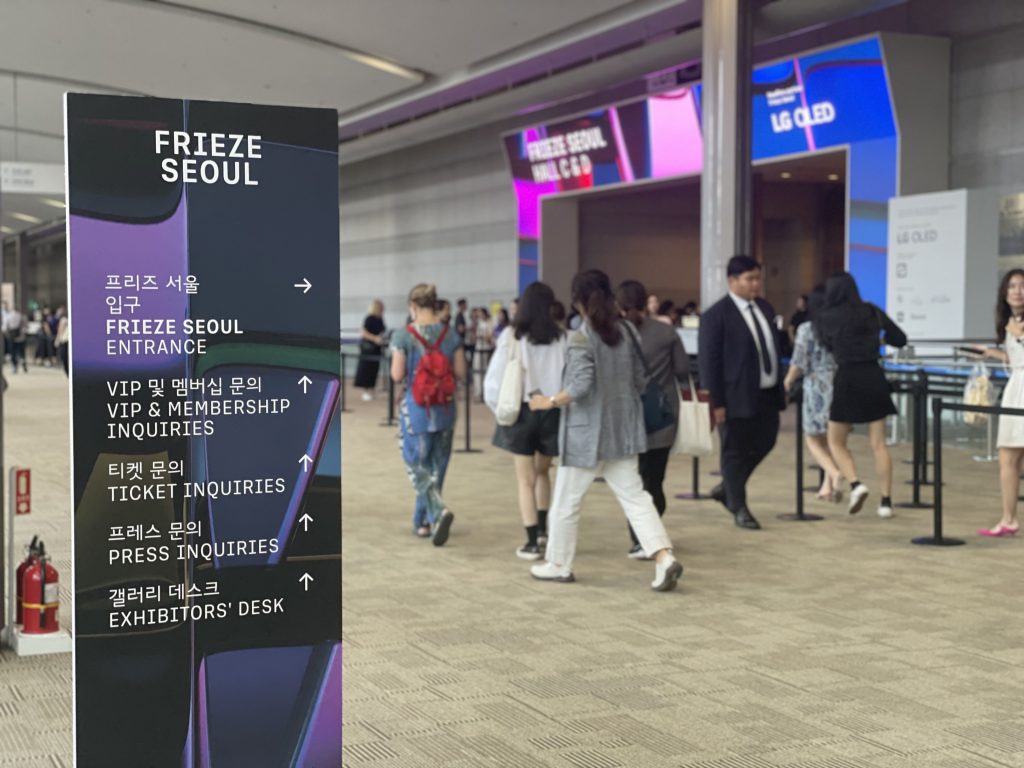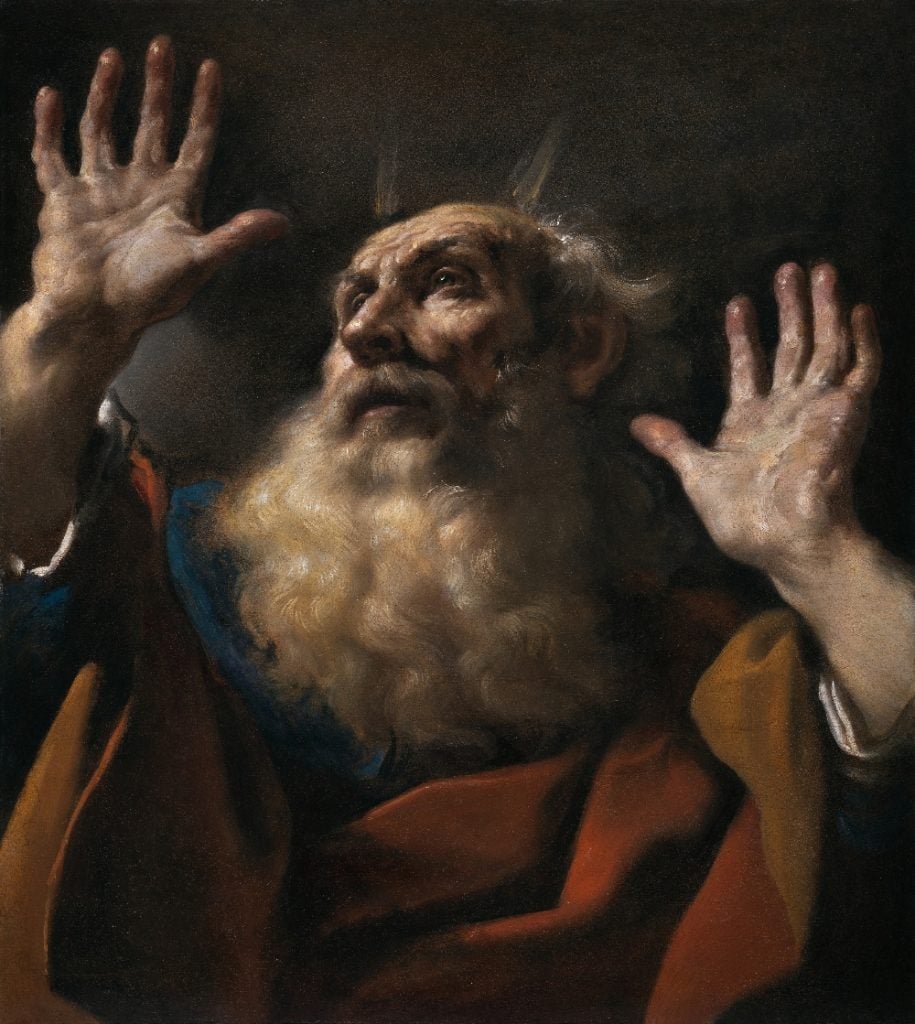Every Friday, Artnet News Pro members get exclusive access to the Back Room, our lively recap funneling only the week’s must-know intel into a nimble read you’ll actually enjoy. (You can subscribe here.)
This week in the Back Room: the state of Seoul’s art-fair landscape, a sleeper Guercino unveiled, and much more—all in a 7-minute read (2,069 words).
Top of the Market
Seoul on Fire?

Frieze Seoul 2023. Photo: Vivienne Chow.
Art world eyes were on Seoul this week, even as New York City geared up for the Armory Show and its parade of satellite fairs. That’s because the second edition of Frieze Seoul and the 22nd edition of the city’s homegrown flagship fair, Kiaf Seoul, which happens alongside and contemporaneously with Frieze, are seen as bellwethers of the city’s viability as a replacement for Hong Kong as de facto art capital of Asia.
But it’s hard to gauge their success for many reasons. First, because 2022 was an outlier year—the novelty of the new Frieze outpost paired with pent up demand and jubilance at the lifting of Covid restrictions conspired to pump up sales at last year’s fairs in Seoul. Second, the global art market has been in a correction in early to mid-2023, the numbers show. Seoul was no exception: Data from Artnet’s Price Database shows that local powerhouses K Auction and Seoul Auction offered 66 percent more lots combined in the first six months of 2023 than in the same period of 2022, but the sales total went down by more 56 percent, from $108 million in to $47 million.
Still, both fairs grew in scope this year, and both attracted more international exhibitors and buyers, as Artnet News’s Vivienne Chow reported from the ground. Frieze’s gallery guest list rose to 121 exhibitors from 110 last year, while Kiaf’s grew from 164 exhibitors to 210 (a 28 percent jump). At Kiaf, the proportion of international galleries in attendance shot up by 33 percent to comprise nearly 40 percent of exhibitors.
Let’s take a closer look at the state of Seoul as an art market, as it nips at the heels of Hong Kong, as the former British colony grows increasingly hostile to expression and dissent, undercutting its appeal as a center of Asian art trade.
What was working in Seoul this year…
- The city is more navigable for foreigners, with Uber legalized, the size of the taxi fleet boosted, and Google Maps now including better geographical information.
- Kiaf organizers also tried to accommodate international exhibitors better, including by offering overseas galleries free advisory on Korean tastes, a useful perk given how unprepared it felt like international exhibitors at Frieze were last year for such a distinct and discerning audience.
- While international galleries are arriving in force, the makeup remains decidedly Asian (30 percent of galleries showing at Frieze), which helps the fair avoid too much overlap with would-be Armory Week exhibitors.
- As art attorneys told Artnet News last week, “with beneficial VAT and sales tax regulations and no capital gains tax on the sale of works below 60 million Korean won (approximately U.S. $55,000) regardless of the artist’s nationality,” the tax benefits for buying and selling in Korea are fantastic. If the work is created by a Korean artist who is living when a transfer is made, no capital gain tax is imposed no matter what the price of the work.
- Kiaf has fostered an experimental streak in parallel with its commercial offerings, with a conceptual piece involving feces collected from different art world professionals taking center stage. Hardly cookie-cutter art fair fare…
What’s still a challenge for Seoul and for Frieze…
- A significantly cooler macroeconomic environment meant slower sales at lower price points; some collectors who “have been buying crazily the past two years have stopped.”
-
Dealers at Frieze brought big-ticket works by Western artists including a $10 million de Kooning canvas at Skarstedt, a $3.5 million Jeff Koons Gazing Ball sculpture at Robilant + Voena, and works by Alex Katz, Joan Mitchell, and Andy Warhol priced between $1 million and $5 million. No word yet on if any of the pieces found buyers. But… confirmed sales were at slightly lower price points: Hauser & Wirth sold a $975,000 piece by Rashid Johnson, Kukje Gallery sold works by Park Seo-bo in the range of $490,000, and a Ha Chong-Hyunin the range of $223,000–$268,000.
- While changes this year at both Frieze and Kiaf saw an uptick in international—particularly western—appeal, there is a growing concern among the local scene to not lose focus on Asian galleries, one of the questions which a new Asian-focused satellite pop-up Our Week hoped to answer.
- The scheduling conflict with the Armory Show, while not terribly intrusive, would best be resolved quickly and decisively.
The Bottom Line
The market in Seoul fared better than expected this year, despite headwinds including economic uncertainty, it drew bigger international crowds and some innovations, particularly geared towards the international visitors. But whether the city truly has the ability to replace Hong Kong as an art center most likely hinges on its ability to broaden its appeal to all of Asia, and its attendant buying power. How does it do that? There weren’t a ton of answers.
Frieze Opening Sales Report
Kiaf Opening Sales Report
Three Art Lawyers Opine
Paint Drippings
The latest Wet Paint was still being mixed at press time. But here’s what else made a mark around the industry since last Friday morning…
Art Fairs
- Minor Attractions, a new “non fair” is the latest to bill itself as a non-commercial, even “radical,” response to an art fair week. The fair premieres in London next month, coinciding with Frieze London, and has editions in the city’s Soho and London Bridge neighborhoods. (The Art Newspaper)
- In New York, as Armory Week kicked off, Steve Buscemi and others celebrated his late wife Jo Andres’s work at Spring/Break Art Show, while Independent 20th Century’s second edition offered a bevy of self-taught artists’ work. (Artnet News, Artnet News)
- A Basel Social Club-inspired art “festival”—definitely not a fair—called Our Week premiered in Seoul as part of the city’s fair week. But the name is… (Our) Weak? (Artnet News)
Auction Houses
- Christie’s has called off the remaining sales of jewels from the estate of Heidi Horten, whose husband was a member of the Nazi Party and made his fortune profiteering from Jewish families under duress. The initial sale fetched $202 million and faced backlash from Jewish organizations, clients, and staff. (Artnet News)
- Phillips is launching a new space in the heart of Milan, with both an office and a gallery for curated exhibitions, events, and sale previews; the first exhibition, opening September 13–15 will feature highlights of the upcoming contemporary and 20th century auctions in London and New York. (Artnet News)
- Auction houses in New York are taking advantage of Amory Week crowds, staging buzzy sales that they would otherwise hold off on until the market’s peak season in November. Sotheby’s has a crush of sartorial sales to coincide with New York Fashion Week with lots like Princess Diana’s sheep sweater, while Bonham’s has a major work by Robert Colescott featured in a single-lot sale. (The Art Newspaper)
Galleries
- Blue-chip gallery Pace is planning to open a Tokyo outpost designed by starchitect Thomas Heatherwick in Spring 2024. Cape Town-based gallery Southern Guild is expanding to Los Angeles next February to coincide with Frieze, marking the first time a South African gallery has had a permanent space in the U.S. Beloved East Village gallery Karma (which also operates a space in L.A.) is opening an outpost in Chelsea. (Artnet News, The Art Newspaper, Artnet News)
- Venice Biennale Golden Lion-winner Sonia Boyce has joined the roster at Hauser & Wirth after departing Simon Lee Gallery, which went into administration due to insolvency this summer. Lorraine O’Grady joins Chicago-based Mariane Ibrahim Gallery after decades with New York’s Alexander Gray Associates. And Gagosian has snagged representation of sculptor Carol Bove from rival mega-gallery David Zwirner. (Artnet News, ARTnews, Artnet News)
Institutions
- Scotland’s V&A Dundee design museum is the latest to drop the disgraced Sackler name, though it did not return a £500,000 donation from the family’s eponymous trust bequeathed back in 2018. (BBC)
- The British Museum has named Sir Mark Jones interim director amid the ongoing theft scandal that resulted in director Hartwig Fischer’s abrupt exit on August 25. Meanwhile, United Talent Agency (UTA) hired ex-Sotheby’s staffer Harrison Tenzer to helm its fine art and artist space divisions in New York. Ingrid Schaffner, formerly curator of the Chinati Foundation in Marfa has joined the curatorial staff at Hauser & Wirth. (Artnet News, The Art Newspaper, ARTnews)
- K11 Art Foundation founder Adrian Cheng is teaming up with arts patron Alia Al-Senussi and prominent Italian collector Patrizia Sandretto Re Rebaudengo to form the K11 Art Foundation International Council, an assemblage of prominent collectors and luminaries working to further K11’s mission to empower and support Chinese contemporary artists. (Press release)
Tech and Legal News
- Canada is the first country other than Ukraine to officially sanction Mikhail Piotrovsky, director of Russia’s State Hermitage Museum in St. Petersburg. (Artnet News)
- A Beijing court has ordered the prominent Chinese artist Ye Yongqing to pay $696,000 in damages to the Belgian artist Christian Silvain, after it found that 122 of his works had plagiarized 87 of Silvain’s. The settlement sum is the highest that has ever been awarded in a case relating to fine arts in China. (Artnet News)
- There are updates in the ongoing legal proceedings related to disgraced financier Jho Low and embattled art advisor Lisa Schiff. From Low’s camp, a seven-figure Picasso drawing was seized by U.S. authorities. Meanwhile, in Schiff’s, new filings indicate that the dethroned dealer is slated to be subject to more criminal investigations and a federal grand jury subpoena. (Artnet News, Artnet News)
“The term is being used to disparagingly refer to any girl out here hustling. We all start somewhere, but in time you learn the rules and who you can trust in the shark filled waters of the art game.”
—Andrea Lledo, head of her own private art advisory service, on the purported pestilence known as gmail art advisors. (Artnet News)
Work of the Week
Guercino’s Moses

Giovanni Francesco Barbieri, also called Il Guercino, Moses. Photo courtesy Moretti Fine Art.
Date: 1618-19
Price: In the range of $2 million
Selling at: Moretti Fine Art
With palms raised upwards as though transfixed in wonder, Moses, in this portrayal by Italian Baroque master Guercino could almost be reacting to its own whopping price tag, which is said to be in the region of €2 million ($2.14 million). This seven-figure sum shows how much difference a year, some restoration, and a great deal of provenance research, can make. In November of last year, when the same work was attributed to an anonymous follower of Guido Reni, it was offered for as little as $5,000 at Chayette and Cheval auction house in Paris.
Eagle-eyed experts took heed of a passing comparison to Guercino in the catalogue notes and the sleeper far surpassed expectations to fetch just over $600,000. Now the work has been authenticated and is believed to have been produced while Guercino was in his late twenties living in Cento, near Bologna. The work’s past has been traced since the earliest record in 1624, as part of the collection of Cardinal Alessandro d’Este, until it was taken to France under Napoleonic rule and eventually lost.
“The discovery of this work constitutes one of the most important additions to Guercino’s oeuvre in recent years,” said Fabrizio Moretti. The stirring composition has developed our understanding of the Old Master’s early mature period, notable for its “dynamism, vigor, and spontaneity.” Moretti plans to exhibit the work at his new Paris gallery next week.
—Jo Lawson-Tancred
Thanks for joining us in the Back Room. See you next Friday.




